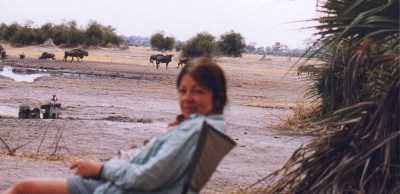Anatolian Shepherds: The Livestock
Guarding Dogs

One of the solutions to prevent conflicts
between predators and farm animals is a pilot Livestock Guarding Dog
program. The CCF began breeding Anatolian Shepherds in 1996. Several
farms in Namibia are already using this method, which is closely monitored by
the CCF.
Anatolian Shepherds are very large and
protective dogs. Properly trained, they will protect livestock as if they
were members of their pack. This is one great tool to keep farm animals
safe from predators.
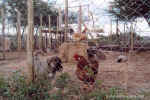 The
hardest part was to see the cute little puppies and not being able to cuddle and
pet them. However, if they are to become good guarding dogs, they must
identify livestock as their family, and not humans.
The
hardest part was to see the cute little puppies and not being able to cuddle and
pet them. However, if they are to become good guarding dogs, they must
identify livestock as their family, and not humans.
I could hardly believe my luck when I was
asked to help with their vaccination! I got to touch all of them... just
briefly.
 In order to make this breeding program work,
the CCF has farm animals which also require care. Our first day's mission
was to vaccinate, worm and rub an anti-parasite solution on about 220
goats. The ground was muddy, and the goats moody. Definitely not a
happy combination. Even though we tried to be gentle, I found myself
grabbing a goat by its hind leg when it tried to escape without having completed
its treatment!
In order to make this breeding program work,
the CCF has farm animals which also require care. Our first day's mission
was to vaccinate, worm and rub an anti-parasite solution on about 220
goats. The ground was muddy, and the goats moody. Definitely not a
happy combination. Even though we tried to be gentle, I found myself
grabbing a goat by its hind leg when it tried to escape without having completed
its treatment!
 Our
ordeal wasn't over. Heavy rains postponed, but not cancelled, the sheep
that needed the same treatment. The ground wasn't as soggy, and with the
help of the Round River students, we got over 80 sheep all set to fight
parasites, worms and other health problems. With the exception of one
sheep that decided to take a bath in the water tank, I can say that we were
pretty dry and happy by the completion of our task.
Our
ordeal wasn't over. Heavy rains postponed, but not cancelled, the sheep
that needed the same treatment. The ground wasn't as soggy, and with the
help of the Round River students, we got over 80 sheep all set to fight
parasites, worms and other health problems. With the exception of one
sheep that decided to take a bath in the water tank, I can say that we were
pretty dry and happy by the completion of our task.
The puppies bred at CCF are placed at farms
when they are about 8 weeks old. We were lucky to join Bonnie on a trip to
a farm about 2 hours away (yes! another chance to touch a puppy), and witness a puppy placement.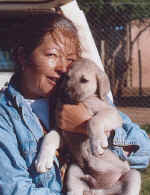
This was a very interesting and educational
experience, as we listened to Bonnie explain to the farm owner how to care and
train the puppy. Among other things, we learned that puppy food is not
advisable for these puppies because it accelerates bone development, and that
the puppy should stay in an area where he could be with livestock, and not with
its human family.
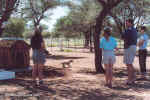 The
puppy was promptly given a nice shaded area with a nice house, and a sheep was
caught to stay with him. We went back to CCF with our empty crate and the
joy of knowing that that puppy can contribute to saving cheetah lives.
The
puppy was promptly given a nice shaded area with a nice house, and a sheep was
caught to stay with him. We went back to CCF with our empty crate and the
joy of knowing that that puppy can contribute to saving cheetah lives.
Another task having to do with farm animals
was feeding and grooming horses. I had ridden horses a few times, but
never stood by one for a prolonged period of time. It is while grooming them
that one can feel their power and strength, and their nobility. I learned
to use different brushes for the soft parts, or the mane and tail. I also
got to know their different personalities. 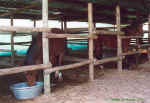
There are nine horses at CCF. My
favorites were Amarula, a beautiful mare with the sweetest disposition, and
Zandu, an old macho with a powerful spirit.
